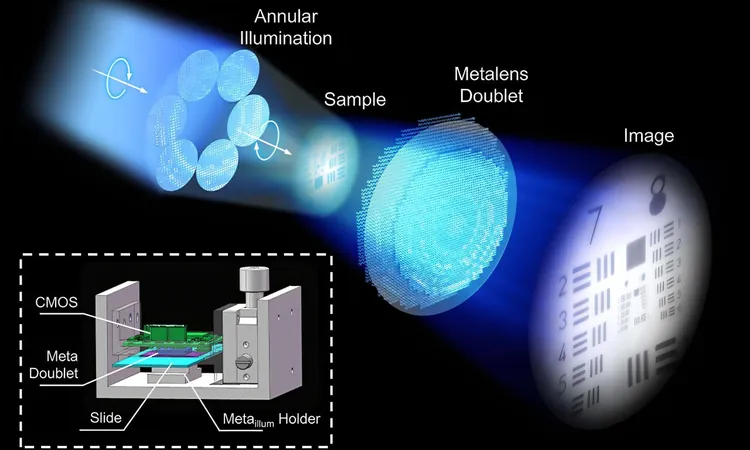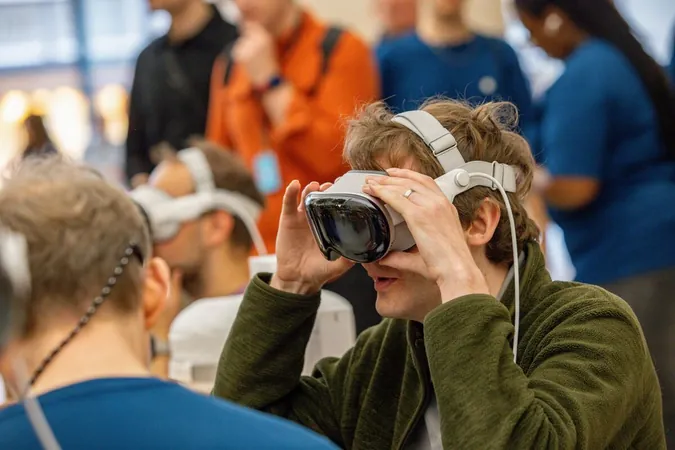
Revolutionary Metalens Microscope: Compact Imaging Redefines Biomedical Research
2025-05-28
Author: Siti
A Breakthrough in Optical Technology
Metalenses are reshaping the landscape of optical technology. Unlike the bulky glass lenses used in traditional microscopes, these cutting-edge devices utilize nanoscale structures to manipulate light on a microscopic level. Their ultra-thin and lightweight nature makes them an appealing choice for integration into compact imaging systems and electronic devices.
Overcoming Challenges in Microscopy
Despite their impressive potential, metalenses have struggled with practical applications in microscopy, primarily due to off-axis aberrations that limit their field of view (FOV) and resolution. This inherent trade-off has hindered their ability to match the performance of traditional microscopes, with previous designs achieving only submicron resolution at the cost of a severely restricted FOV.
A New Era in Bioimaging
Enter a groundbreaking solution from a research team at Nanjing University, China. Their recent publication in Advanced Photonics unveils a revolutionary metalens-based microscope that marries wide FOV with high-resolution imaging—all packed into a compact design. By employing a doublet configuration—two metalenses positioned on either side of a transparent silica substrate—along with annular illumination, they've tackled the fundamental limitations previously faced.
Technical Innovations Lead to Breakthroughs
The researchers crafted the dual metalenses from silicon nitride nano-fins, specifically designed as high-aspect-ratio squares and meticulously spaced. This innovative setup reduces off-axis aberrations and significantly enhances resolution—all key factors in optimizing imaging performance. Dr. Tao Li, the lead author, proudly states, "Our metalens microscope boasts a FOV of up to 150 µm and a half-pitch resolution of 310 nm, surpassing any prior records in meta-microscopy."
Compact, Powerful, and Effective
The team has also created a compact prototype of their meta-microscope that offers a 1 mm FOV and an impressive half-pitch resolution of 620 nm. What sets this device apart is its ability to generate annular illumination through metasurfaces, contributing to the device's remarkable compactness—measuring just 4 cm x 4 cm x 5 cm—a thousand-fold decrease in size compared to standard microscopes.
Real-World Applications in Cancer Research
Demonstrating the system's capabilities, the researchers utilized their meta-microscope to image cervical cancer cells. They successfully captured images showcasing various stages of cancer development, highlighting critical cellular features like nuclear enlargement, deformation, and division within the same FOV. This ability to observe significant details across a wide field could greatly enhance diagnostic capabilities for healthcare professionals.
A Game Changer for Portable Imaging
Dr. Li emphasizes that their experimental results yield high-quality bioimages comparable to those obtained from traditional microscopes, expressing the technology's potential for portable and convenient applications. This breakthrough could prove invaluable in resource-limited settings, mobile health monitoring, or outdoor research environments where conventional microscopes are impractical.
The Future of Metalens Technology
The possibility of integrating this technology into microelectronic devices opens the door to advanced clinical systems and biomedical automation. Overall, this innovative approach marks a pivotal advancement in metalens-based imaging systems, positioning them to rival traditional optics while offering distinct advantages in size and versatility.




 Brasil (PT)
Brasil (PT)
 Canada (EN)
Canada (EN)
 Chile (ES)
Chile (ES)
 Česko (CS)
Česko (CS)
 대한민국 (KO)
대한민국 (KO)
 España (ES)
España (ES)
 France (FR)
France (FR)
 Hong Kong (EN)
Hong Kong (EN)
 Italia (IT)
Italia (IT)
 日本 (JA)
日本 (JA)
 Magyarország (HU)
Magyarország (HU)
 Norge (NO)
Norge (NO)
 Polska (PL)
Polska (PL)
 Schweiz (DE)
Schweiz (DE)
 Singapore (EN)
Singapore (EN)
 Sverige (SV)
Sverige (SV)
 Suomi (FI)
Suomi (FI)
 Türkiye (TR)
Türkiye (TR)
 الإمارات العربية المتحدة (AR)
الإمارات العربية المتحدة (AR)